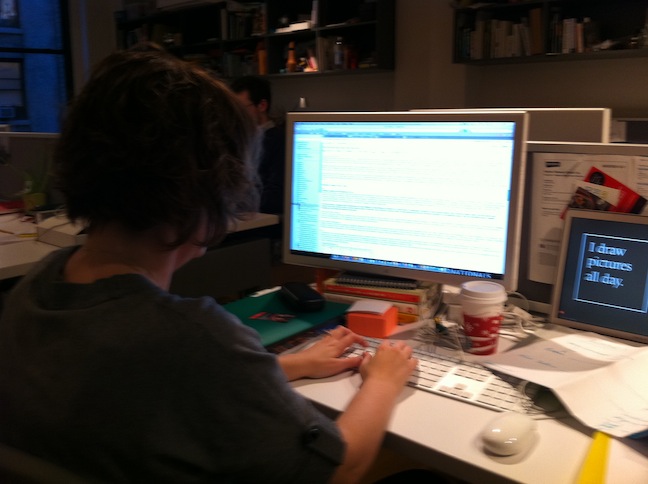Prototypes
Easy Prototyping
Early on in the process, I tried to think of simple prototypes that would be possible without diving into anything technical. Here were a few of my ideas:
- Give someone a bell to ring whenever they feel distracted.
- Observe someone working and give them a report card at the end of how they’re working.
- Observe someone working and tell them when to take a break.
- Observe someone working and interrupt them when they get too distracted.
- Observe someone working, and stop them and make a note when they try to engage with a distraction. Then when they take a break, remind them of their attempted distraction so they can resume it.
- Organize a communal work session so that everyone is on the same distraction schedule.
- Install Freedom or SelfControl on a participant’s computer and see if it reduces their distraction.
- Slow down someone’s internet connection as they get more distracted.
- Place a participant in a quiet room and observe how they work.
- Screen share (VNC, for instance) with someone as they’re working to keep an eye on it.
- Observe someone and ask them to justify every app switch or new website that they visit.
Shoulder Tapping
I decided to try out one of my prototypes in person. The concept was simple: I would work with one participant for the prototype. While the participant was working, I would sit next to her and watch over her. Whenever she got distracted, I would tap on her shoulder to try and get her back on track. For this prototype, I defined “distracted” as looking at a web site that was not related to her goal of writing a blog entry. I watched over her should for about a half hour, which was the entire duration of the task.

The results were mixed. Here are some of the highlights:
- I think that being in the situation (watching over her shoulder) had a significant affect on her work concentration. I sort of suspected this would happen, since in my interviews I had a few people mention that being in a position where your screen is visible makes you less likely to spend time surfing the web in case someone is watching you. This is a good note for the next prototype: I should do something more covert.
- She was working under a self-imposed deadline for the writing, so it’s possible that she was very focused by her own volition.
- She went back and forth between a few apps during the writing. All of those switches (except for the Mail check, below) were in support of the writing goal.
- The first time she was distracted, she went to check her email. It was only a brief interruption, but I tapped her on the shoulder. She said, “What am I supposed to do when I get distracted? You can’t ignore the red dot [on the Mail icon].” This is a surprisingly obvious question for which I do not yet have an answer.
- The second time she was distracted, she had finished writing the blog entry except for the conclusion. She said that she was going to check recent updates on Twitter before she wrote the conclusion, since that was the hardest part of writing and she wanted to make sure she was refreshed. This behavior supports my interview findings that people generally only act on a distraction when they reach a milestone. Interestingly, this pre-empted my shoulder tapping, since she knew she would get a shoulder tap by checking Twitter.
Distractometer
To end the first semester, I created a simple software prototype that demonstrated the ability to track a user’s activity. This system makes no attempt at intervening when someone becomes too distracted, but it demonstrates the feasability of activity tracking.
Copyright © 2010 - 2011 Eric St. Onge
Please send questions or comments to eric at ericstonge dot com.